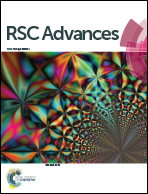Controllable synthesis of porous iron–nitrogen–carbon nanofibers with enhanced oxygen reduction electrocatalysis in acidic medium†
Abstract
We synthesized porous Fe–N–C nanofibers as non-precious metal catalysts to investigate the impact of surface area on electrocatalysis performance. The surface area was modified by adjusting the proportion of the added silicon nanoparticles, and achieved a 20 times enhancement of the electrocatalysis performance at an optimized proportion.


 Please wait while we load your content...
Please wait while we load your content...